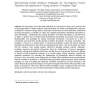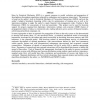34 search results - page 6 / 7 » Population models from PEPA descriptions |
BMCBI
2005
13 years 7 months ago
2005
Background: Functional analysis of data from genome-scale experiments, such as microarrays, requires an extensive selection of differentially expressed genes. Under many condition...
SAC
2006
ACM
14 years 1 months ago
2006
ACM
: In chip design, one of the main objectives is to decrease its clock cycle; however, the existing approaches to timing analysis under uncertainty are based on fundamentally restri...
CORR
2006
Springer
13 years 7 months ago
2006
Springer
Ideas by Statistical Mechanics (ISM) is a generic program to model evolution and propagation of ideas/patterns throughout populations subjected to endogenous and exogenous interac...
ICRA
2005
IEEE
14 years 1 months ago
2005
IEEE
— The aim of this paper is to investigate how stigmergic information allow each individual of a group of autonomous robots to take advantages from other individual behaviors. The...
SIGIR
2010
ACM
13 years 11 months ago
2010
ACM
How does the web search behavior of “rich” and “poor” people differ? Do men and women tend to click on different results for the same query? What are some queries almost...


